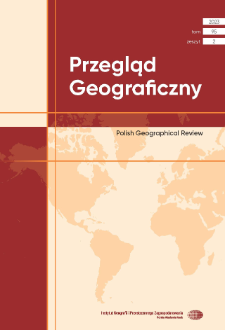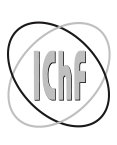- Search in all Repository
- Literature and maps
- Archeology
- Mills database
- Natural sciences
Advanced search
Advanced search
Advanced search
Advanced search
Advanced search

Object
Title: Zależności Z-R dla różnych typów opadów jako narzędzie do radarowego szacowania wielkości opadów = The Z-R relationships for different types of precipitation as a tool for radar-based precipitation estimation
Creator:
Barszcz, Mariusz Paweł
:
Autor
![]()
![]() ;
Stańczyk, Tomasz
:
Autor
;
Stańczyk, Tomasz
:
Autor
![]()
![]() ;
Brandyk, Andrzej
:
Autor
;
Brandyk, Andrzej
:
Autor
![]()
![]()
Date issued/created:
Resource type:
Subtitle:
Przegląd Geograficzny T. 95 z. 2 (2023)
Publisher:
Place of publishing:
Description:
Abstract:
Disdrometr laserowy umożliwia pomiar wielkości odbiciowości (Z) i intensywności opadów (R) z dużą rozdzielczością czasową. W tych badaniach wykorzystano 95 459 par danych Z-R o rozdzielczości czasowej 1 min, które zostały zarejestrowane na terenie Warszawy przez disdrometr laserowy Parsivel1 firmy OTT w latach 2012‑2014 oraz 2019‑2020 (w okresach od kwietnia do października). Najpierw wyznaczono zależność między wartościami odbiciowości i intensywności opadów na podstawie wszystkich danych pomiarowych. Zasadniczym celem podjętych badań było wyznaczenie zależności Z-R odrębnie dla trzech typów opadów: deszczu, deszczu ze śniegiem, śniegu. Przeprowadzone badania wykazały duże różnice między wartościami parametru a (mnożnika) zależności Z-R typu potęgowego, ustalonymi dla trzech wymienionych typów opadów. Uzyskane wyniki wskazują na potrzebę uwzględnienia relacji Z-R dopasowanych do określonych typów opadów w procedurze przetwarzania danych radarowych, co mogłoby poprawić szacunki wielkości opadów z radarów meteorologicznych należących do ogólnopolskiego systemu POLRAD.
References:
Atlas, D. & Chmela, A.C. (1957). Physical-synoptic variations of drop-size parameters. W: Preprints, sixth weather radar conference (s. 21‑19). Boston, MA: American Meteorological Society.
Amengual, A. (2022). Hydrometeorological analysis of the 12 and 13 September 2019 widespread flash flooding in eastern Spain. Natural Hazard and Earth System Sciences, 22, 1159‑1179. https://doi/org/10.5194/nhess-22-1159-2022
![]()
Berne, A., Delrieu, G., Creutin, J.-D., & Obled, C. (2004). Temporal and spatial resolution of rainfall measurements required for urban hydrology. Journal of Hydrology, 299(3‑4), 166‑179.
![]()
Biniak-Pieróg, M., Biel, G., Szulczewski, W., & Żyromski, A. (2015). Evaluation of methods of comparative analysis of sums of atmospheric precipitation measured with the classical method and with a contact-less laser rain gauge. Annals of Warsaw University of Life Sciences - SGGW Land Reclamation, 47, 371‑382. https://doi/org/10.1515/sggw-2015-0038
![]()
Biniak-Pieróg, M. (2017). Monitoring of atmospheric precipitation and soil moisture as basis for the estimation of effective supply of soil profile with water. Monografie 207. Wrocław: Wydawnictwo Uniwersytetu Przyrodniczego.
Bouilloud, L., Delrieu, G., Boudevillain, B., & Kirstetter, P.-E. (2010). Radar rainfall estimation in the context of post-event analysis of flash-flood events. Journal of Hydrology, 394(1‑2), 17‑27. https://doi/org/10.1016/j.jhydrol.2010.02.035
![]()
Bournas, A. & Baltas, E. (2022). Determination of the Z-R Relationship through Spatial Analysis of X-Band Weather Radar and Rain Gauge Data. Hydrology, 9, 137. https://doi/org/10.3390/hydrology9080137
![]()
Burszta-Adamiak, E. (2012). Analysis of Stormwater Retention on Green Roofs/Badania Retencji Wód Opadowych Na Dachach Zielonych. Archives of Environmental Protection, 38, 3‑13. https://doi/org/10.2478/v10265-012-0035-3
![]()
Chumchean, S., Sharma, A., & Seed, A. (2003). Radar rainfall error variance and its impact on radar rainfall calibration. Physics and Chemistry of the Earth, 28(1‑3), 27‑39. https://doi/org/10.1016/S1474-7065(03)00005-6
![]()
Conti, F.L., Francipane, A., Pumo, D., & Noto, L.V. (2015). Exploring single polarization X-band weather radar potentials for local meteorological and hydrological applications. Journal of Hydrology, 531, 508‑522. https://doi/org/10.1016/j.jhydrol.2015.10.071
![]()
Delrieu, G., Bonnifait, L., Kirstetter, P.-E., & Boudevillain, B. (2014). Dependence of radar quantitative precipitation estimation error on the rain intensity in the Cévennes region, France. Hydrological Sciences Journal, 59(7), 1308‑1319.
![]()
Dotzek, N. & Beheng, K.D. (2001). The influence of deep convective motions on the variability of Z-R relations. Atmospheric Research, 59, 15‑39. https://doi/org/10.1016/S0169-8095(01)00107-7
![]()
Gualco, L.F, Campozano, L., Maisincho, L., Robaina, L., Muñoz, L., Ruiz-Hernández, J.C., Villacís, M., & Condom, T. (2021). Corrections of Precipitation Particle Size Distribution Measured by a Parsivel OTT2 Disdrometer under Windy Conditions in the Antisana Massif, Ecuador. Water, 13, 2576. https://doi.org/10.3390/w13182576
![]()
Gunn, K.L.S. & Marshall, J.S. (1958). The distribution with size of aggregate snowflakes. Journal of Meteorology, 15, 452‑461.
![]()
Guyot, A., Pudashine, J., Protat, A., Uijlenhoet, R., Pauwels, V.R.N., Seed, A., & Walker, J.P. (2019). Effect of disdrometer type on rain drop size distribution characterization: a new dataset for Southeastern Australia. Hydrol. Earth Syst. Sci., 23, 4737‑4761. https://doi/org/10.5194/hess-23-4737-2019
![]()
Hazenberg, P., Yu, N., Boudevillain, B., Delrieu, G., & Uijlenhoet, R. (2011). Scaling of raindrop size distributions and classification of radar reflectivity- rain rate relations in intense Mediterranean precipitation. Journal of Hydrology, 402, 179‑192. https://doi/org/10.1016/j.jhydrol.2011.01.015
![]()
He, X., Sonnenborg, T.O., Refsgaard, J.C., Vejen, F., & Jensen, K.H. (2013). Evaluation of the value of radar QPE data and rain gauge data for hydrological modeling. Water Resources Research, 49(9), 5989‑6005. https://doi/org/10.1002/wrcr.20471
![]()
Hunter, S. (1996). WSR-88D radar rainfall estimation: capabilities, limitations and potential improvements. National Weather Digest, 20(4), 26‑36.
Jaffrain, J. & Berne. A. (2011). Experimental quantification of the sampling uncertainty associated with measurements from PARSIVEL disdrometers. Journal of Hydrometeorology, 12, 352‑370. https://doi/org/10.1175/2010JHM1244.1
![]()
Jakubiak, B., Licznar, P., & Malinowski, Sz.P. (2014). Rainfall estimates from radar vs. raingauge measurements. Warsaw case study. Environment Protection Engineering, 40(2), 159‑170. https://doi/org/10.5277/epel140212
![]()
Jiang, Y., Yang, L., Zeng, Y., Tong, Z., Li, J., Liu, F., Zhang, J., & Liu, J. (2022). Comparison of summer raindrop size distribution characteristics in the western and central Tianshan Mountains of China. Meteorological Applications, 29(3), e2067. https://doi/org/10.1002/met.2067
![]()
Johannsen, L.L., Zambon, N., Strauss, P., Dostal, T., Neumann, M., Zumr, D., Cochrane, T.A., Blöschl, G., & Klik, A. (2020). Comparison of three types of laser optical disdrometers under natural rainfall conditions. Hydrological Sciences Journal, 65(4), 524‑535. https://doi/org/10.1080/02626667.2019.1709641
![]()
Joss, J. & Waldvogel, A. (1970). A method to improve the accuracy of radar-measured amounts of precipitation, In: Preprints, 14th Radar Meteorology Conference (s. 237‑238). Tucson, AZ: American Meteorological Society.
Jwa, M., Jin, H-G., Lee, J., Moon, S., & Baik, J-J. (2020). Characteristics of Raindrop Size Distribution in Seoul, South Korea According to Rain and Weather Types. Asia-Pacific Journal of Atmospheric Sciences, 57(3), 605‑617. https://doi/org/10.1007/s13143-020-00219-w
![]()
Krajewski, W.F., Kruger, A., Caracciolo, C., Golé, P., Barthes, L., Creutin, J-D., Delahaye, J-Y., Nikolopoulos, E.I., Ogden, F., & Vinson, J-P. (2006). DEVEX-Disdrometer Evaluation Experiment: Basic results and implications for hydrologic studies. Advances in Water Resources, 29, 311‑325. https://doi/org/10.1016/j.advwatres.2005.03.018
![]()
Licznar, P. (2009). Wstępne wyniki porównawczych testów polowych elektronicznego deszczomierza wagowego OTT Pluvio2 i disdrometru laserowego Parsivel. Instal, 7/8, 43‑50.
Licznar, P., & Krajewski, W.F. (2016). Precipitation Type Specific Radar Reflectivity-rain Rate Relationship for Warsaw, Poland. Acta Geophysica, 64(5), 1840‑1857.
![]()
Licznar, P., & Siekanowicz-Grochowina, K. (2015). Wykorzystanie disdrometru laserowego do kalibracji obrazów pochodzących z radarów opadowych na przykładzie Warszawy. Ochrona Środowiska, 37(2), 11‑16.
Marshall, J.S. & Palmer, W.McK. (1948). The distribution of raindrops with size. Journal of Meteorology, 5, 165‑166. http://doi.org/10.1175/1520-0469(1948)005<0165:TDORWS>2.0.CO; 2
![]()
Marshall, J.S., Hitschfeld, W., & Gunn, K.L.S. (1955). Advances in radar weather. Advances in Geophysics, 2, 1‑56. https://doi/org/10.1016/S0065-2687(08)60310-6
![]()
Moriasi, D.N., Arnold, J.G., Van Liew, M.W., Bingner, R.L., Harmel, R.D., & Veith, T.L. (2007). Model evaluation guidelines for systematic quantification of accuracy in watershed simulations. Transactions of the ASABE, 50(3), 885‑900. https://doi/org/10.13031/2013.23153
![]()
Moszkowicz, S., & Tuszyńska, I. (2006). Meteorologia radarowa. Podręcznik użytkownika informacji radarowej IMGW. Warszawa: Instytut Meteorologii i Gospodarki Wodnej.
Szewrański, S. (2009). Rozbryzg jako forma erozji wodnej gleb lessowych. Monografie 78. Wrocław: Wydawnictwo Uniwersytetu Przyrodniczego we Wrocławiu.
Thorndahl, S., Einfalt, T., Willems, P., Nielsen, J.E., Veldhuis, M.-C., Arnbjerg-Nielsce, K., Rasmussen, M.R., & Molnar, P. (2017). Weather radar rainfall data in urban hydrology. Hydrology and Earth System Sciences, 21, 1359‑1380.
![]()
Thurai, M., Petersen, W.A., Tokay, A., Schultz, C., & Gatlin, P. (2011). Drop size distribution comparisons between Parsivel and 2-D video disdrometers. Advances in Geosciences, 30, 3‑9. https://doi/org/10.5194/adgeo-30-3-2011
![]()
Tokay, A., Peterson, W.A., Gatlin, P., & Wingo, M. (2013). Comparison of raindrop size distribution measurements by collocated disdrometers. Journal of Atmospheric and Oceanic Technology, 30(8), 1672‑1690. https://doi/org/10.1175/JTECH-D-12-00163.1
![]()
Tokay, A., Wolff, D.B., & Petersen, W.A. (2014). Evaluation of the new version of the laser-optical disdrometer, OTT Parsivel2. Journal of Atmospheric and Oceanic Technology, 31, 1276‑1288. https://doi/org/10.1175/JTECH-D-13-00174.1
![]()
Villarini, G. & Krajewski, W.F. (2010). Review of the different sources of uncertainty in single polarization radar-based estimates of rainfall. Surveys in Geophysics, 31(1), 107‑129. https://doi/org/10.1007/s10712-009-9079-x
![]()
Relation:
Volume:
Issue:
Start page:
End page:
Detailed Resource Type:
Format:
Resource Identifier:
oai:rcin.org.pl:239217 ; doi:10.7163/PrzG.2023.2.2 ; 0033-2143 (print) ; 2300-8466 (on-line) ; 10.7163/PrzG.2023.2.2
Source:
CBGiOŚ. IGiPZ PAN, sygn.: Cz.181, Cz.3136, Cz.4187 ; click here to follow the link
Language:
Language of abstract:
Rights:
Licencja Creative Commons Uznanie autorstwa 4.0
Terms of use:
Zasób chroniony prawem autorskim. [CC BY 4.0 Międzynarodowe] Korzystanie dozwolone zgodnie z licencją Creative Commons Uznanie autorstwa 4.0, której pełne postanowienia dostępne są pod adresem: ; -
Digitizing institution:
Instytut Geografii i Przestrzennego Zagospodarowania Polskiej Akademii Nauk
Original in:
Projects co-financed by:
Program Operacyjny Innowacyjna Gospodarka, lata 2010-2014, Priorytet 2. Infrastruktura strefy B + R ; Unia Europejska. Europejski Fundusz Rozwoju Regionalnego
Access:
Object collections:
- Digital Repository of Scientific Institutes > Partners' collections > Institute of Geography and Spatial Organization PAS (IGiPZ PAN) > Publications of IGiPZ PAN and employees
- Digital Repository of Scientific Institutes > Partners' collections > Institute of Geography and Spatial Organization PAS (IGiPZ PAN) > Library > Series/Journals/Periodics
- Digital Repository of Scientific Institutes > Literature > Journals/Articles
Last modified:
Jan 15, 2025
In our library since:
Aug 7, 2023
Number of object content downloads / hits:
138
All available object's versions:
https://rcin.org.pl./publication/275624
Show description in RDF format:
Show description in RDFa format:
Show description in OAI-PMH format:
Objects Similar
Barszcz, Mariusz Paweł
Barszcz, Mariusz Paweł
Barszcz, Mariusz Paweł Kazanowska, Ewa Wasilewicz, Michał

 INSTYTUT ARCHEOLOGII I ETNOLOGII POLSKIEJ AKADEMII NAUK
INSTYTUT ARCHEOLOGII I ETNOLOGII POLSKIEJ AKADEMII NAUK
 INSTYTUT BADAŃ LITERACKICH POLSKIEJ AKADEMII NAUK
INSTYTUT BADAŃ LITERACKICH POLSKIEJ AKADEMII NAUK
 INSTYTUT BADAWCZY LEŚNICTWA
INSTYTUT BADAWCZY LEŚNICTWA
 INSTYTUT BIOLOGII DOŚWIADCZALNEJ IM. MARCELEGO NENCKIEGO POLSKIEJ AKADEMII NAUK
INSTYTUT BIOLOGII DOŚWIADCZALNEJ IM. MARCELEGO NENCKIEGO POLSKIEJ AKADEMII NAUK
 INSTYTUT BIOLOGII SSAKÓW POLSKIEJ AKADEMII NAUK
INSTYTUT BIOLOGII SSAKÓW POLSKIEJ AKADEMII NAUK
 INSTYTUT CHEMII FIZYCZNEJ PAN
INSTYTUT CHEMII FIZYCZNEJ PAN
 INSTYTUT CHEMII ORGANICZNEJ PAN
INSTYTUT CHEMII ORGANICZNEJ PAN
 INSTYTUT FILOZOFII I SOCJOLOGII PAN
INSTYTUT FILOZOFII I SOCJOLOGII PAN
 INSTYTUT GEOGRAFII I PRZESTRZENNEGO ZAGOSPODAROWANIA PAN
INSTYTUT GEOGRAFII I PRZESTRZENNEGO ZAGOSPODAROWANIA PAN
 INSTYTUT HISTORII im. TADEUSZA MANTEUFFLA POLSKIEJ AKADEMII NAUK
INSTYTUT HISTORII im. TADEUSZA MANTEUFFLA POLSKIEJ AKADEMII NAUK
 INSTYTUT JĘZYKA POLSKIEGO POLSKIEJ AKADEMII NAUK
INSTYTUT JĘZYKA POLSKIEGO POLSKIEJ AKADEMII NAUK
 INSTYTUT MATEMATYCZNY PAN
INSTYTUT MATEMATYCZNY PAN
 INSTYTUT MEDYCYNY DOŚWIADCZALNEJ I KLINICZNEJ IM.MIROSŁAWA MOSSAKOWSKIEGO POLSKIEJ AKADEMII NAUK
INSTYTUT MEDYCYNY DOŚWIADCZALNEJ I KLINICZNEJ IM.MIROSŁAWA MOSSAKOWSKIEGO POLSKIEJ AKADEMII NAUK
 INSTYTUT PODSTAWOWYCH PROBLEMÓW TECHNIKI PAN
INSTYTUT PODSTAWOWYCH PROBLEMÓW TECHNIKI PAN
 INSTYTUT SLAWISTYKI PAN
INSTYTUT SLAWISTYKI PAN
 SIEĆ BADAWCZA ŁUKASIEWICZ - INSTYTUT TECHNOLOGII MATERIAŁÓW ELEKTRONICZNYCH
SIEĆ BADAWCZA ŁUKASIEWICZ - INSTYTUT TECHNOLOGII MATERIAŁÓW ELEKTRONICZNYCH
 MUZEUM I INSTYTUT ZOOLOGII POLSKIEJ AKADEMII NAUK
MUZEUM I INSTYTUT ZOOLOGII POLSKIEJ AKADEMII NAUK
 INSTYTUT BADAŃ SYSTEMOWYCH PAN
INSTYTUT BADAŃ SYSTEMOWYCH PAN
 INSTYTUT BOTANIKI IM. WŁADYSŁAWA SZAFERA POLSKIEJ AKADEMII NAUK
INSTYTUT BOTANIKI IM. WŁADYSŁAWA SZAFERA POLSKIEJ AKADEMII NAUK




































